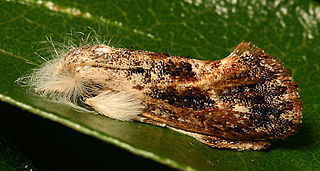
Stipa is a genus of around 300 large perennial hermaphroditic grasses collectively known as feather grass, needle grass, and spear grass. They are placed in the subfamily Pooideae and the tribe Stipeae, which also contains many species formerly assigned to Stipa, which have since been reclassified into new genera.

Sinningia is a genus of flowering plants in the family Gesneriaceae. It is named after Wilhelm Sinning (1792–1874), a gardener of the Botanische Gärten der Friedrich-Wilhelms-Universität Bonn. There are about 65 species of tuberous herbaceous perennials, all occurring in Central and South America, with the greatest concentration of species occurring in southern Brazil.

Podosphaera leucotricha is a plant pathogen that can cause powdery mildew of apples and pears.

Opuntia leucotricha is a species of cactus with the common names: arborescent pricklypear, Aaron's beard cactus, and semaphore cactus; and duraznillo blanco and nopal blanco.

Acrolophus is a genus of moths in the family Acrolophidae, with, typically, great individual variation within species in color pattern, making field identification of many individuals difficult or impossible. It was described by Felipe Poey in 1832.
Semolina is a genus of moth in the family Cosmopterigidae. It contains only one species, Semolina leucotricha, which is found on Rapa Iti.

Nassella leucotricha is a species of grass known by the common names Texas wintergrass, Texas needlegrass, and Texas tussockgrass. It is native to the south-central United States and much of Mexico.

Acrolophus popeanella is a moth of the family Acrolophidae. It is found in the eastern United States, from New Jersey and Ohio south to Florida and west to Illinois, Nebraska and Texas.
Acrolophus fervidus is a moth of the family Acrolophidae described by August Busck in 1912. It is found in Costa Rica, Mexico and Texas.

Acrolophus arcanella is a moth of the family Acrolophidae. It is found in eastern North America.

The grass tubeworm or Texas grass tubeworm moth is a moth of the family Acrolophidae. It is found from Maryland to Florida and to Texas.
Acrolophus macrogaster is a moth of the family Acrolophidae. It is found in North America, including Arizona.
Walsingham's grass tubeworm moth is a moth of the family Acrolophidae. It is found in North America, including Alabama, Florida, Georgia, Illinois, Louisiana, Maryland, Mississippi, New York, Ohio, South Carolina, Tennessee, Virginia and West Virginia.
Acrolophus cockerelli is a moth of the family Acrolophidae. It is found in North America, including Arizona, Nevada, New Mexico, Oklahoma, Oregon and Texas.
Acrolophus echinon is a moth of the family Acrolophidae. It is found in Mexico.
Acrolophus mimasalis is a moth of the family Acrolophidae. It is found in the West Indies.
Acrolophus maculata is a moth of the family Acrolophidae. It is found in Brazil.
Acrolophus sinclairi is a moth of the family Acrolophidae. It is found in North America, including California, New Mexico and Texas.
Acrolophus numidia is a moth of the family Acrolophidae first described by Herbert Druce in 1901. It is found in Mexico.
Acrolophus walsinghami is a moth of the family Acrolophidae. It is found in Puerto Rico.








